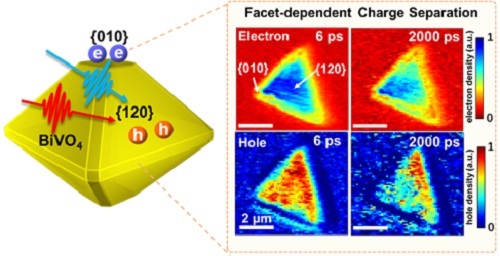Photocatalytic reactions that produce solar fuels through water splitting and carbon dioxide reduction offer a promising pathway for solar fuel production. A typical photocatalytic reaction consists of a complex sequence, among which the separation of photogenerated charges is a critical and long-standing challenge. This challenge limits the catalytic activity of photocatalysts and the efficiency of solar-to-chemical energy conversion, as it involves the movement of photogenerated charges across various temporal and spatial scales.
Recently, a joint research team led by Prof. JIN Shengye, Prof. TIAN Wenming, Prof. LI Rengui, and Prof. LI Can from the Dalian Institute of Chemical Physics (DICP) of the Chinese Academy of Sciences (CAS) has visualized the ultrafast charge separation process in facet-engineered photocatalyst crystals by using a home-built pump-probe transient reflection microscope (TRM). The study was published in the Journal of the American Chemical Society.

Schematic illustration of spatiotemporal mapping measurements as well as the electron and hole density distribution (Image by TIAN Wenming)
The researchers employed TRM to directly observe the temporal and spatial evolution of photogenerated electrons and holes on the surface of a typical photocatalyst: facet-engineered bismuth vanadate (BiVO4).
The researchers demonstrated that the anisotropic built-in field within BiVO4 crystals facilitated the separation of photogenerated electrons and holes toward different facets through a two-step process spanning various timescales. Initially, the electrons and holes underwent ultrafast separation within around 6 picoseconds, with the electrons converting into localized small polarons after migrating toward the {010} facets of the truncated BiVO4 octahedral crystals. In contrast, the photogenerated holes prolong their separation, moving in a drift-diffusion manner over approximately 2,000 picoseconds before eventually accumulating on the {120} facets.
Furthermore, the researchers analyzed the charge separation dynamics and demonstrated that such ultrafast separation could offer an unexpected route to enhance charge separation efficiency in BiVO4 crystals, supporting good photocatalytic performance.
This work was supported by the National Natural Science Foundation of China, the CAS Projects for Young Scientists in Basic Research, the Liaoning Revitalization Talents Program, and the Fundamental Research Funds for the Central Universities.